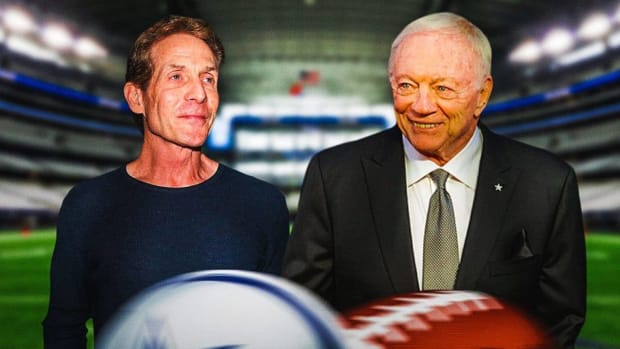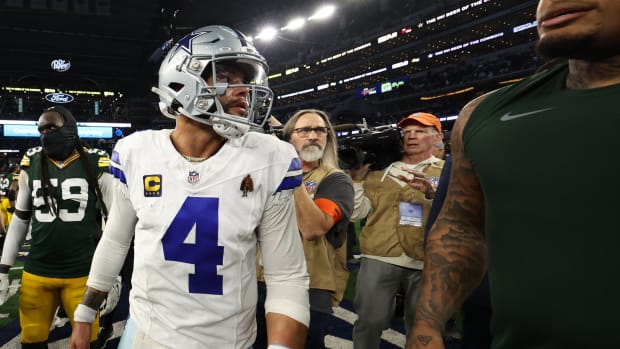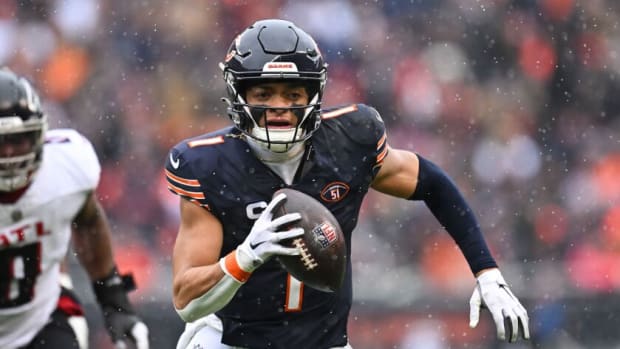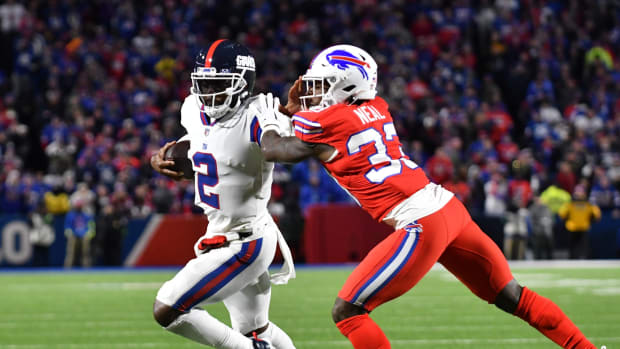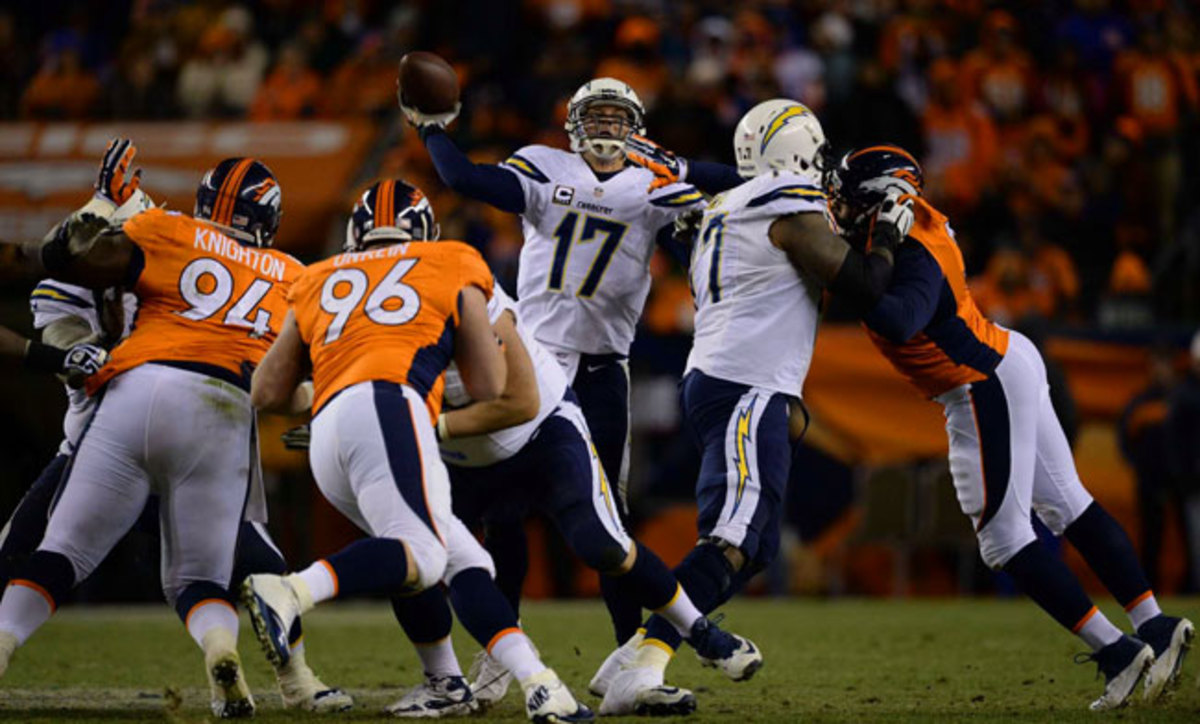
Philip Rivers Plays QB in Its Purest Form
No quarterback generates more production with his feet than Philip Rivers. Though he sometimes looks like he’s wearing ski boots in the sand, we’re not talking about running in the sense of tucking the ball and taking off. We’re talking about generating production with his feet. Unlike Russell Wilson, whose feet cover large swaths of ground to make plays, Rivers covers inches of ground. But with those inches comes tremendous productivity, in the form of balls unleashed accurately through the air.
The details might be microscopic, but Rivers’s pocket movement is the best in football. He sidesteps to avoid pressure; he hitches up to create throwing velocity and let pass rushers go past him; he slides and drifts to camouflage his blockers’ mistakes. Occasionally Rivers will get outside the pocket altogether. He’s adept here as well, though he’s not comfortable throwing literally on the move; he often has to stop and reset before releasing. Nevertheless, the results are usually the same: positive yardage.
His style of play is quarterbacking in its purest form. This is how every coach wants his QB to play. You can draw up any passing concept for a man who has mastered nuanced movement.
Rivers should get more balance and support from the ground game, which almost always carries a positive effect for a passing attack—especially when you’re talking about a veteran quarterback who can identify safety rotations after the snap.
Rivers doesn’t need his feet to be very far apart in order to throw. That weird shot-put motion that he picked up as a little kid by heaving full-sized footballs years before puberty? It looks goofy, but it’s also extremely compact. Which is a great trait if you have the raw arm strength. It enables Rivers to make throws with bodies around him. Not needing much space in order to launch, Rivers is afforded more possibilities for places to move. It might not appear that way because those possibilities all exist within the pocket, but his ability to maximize those overlapping inches is what makes San Diego’s offense go.
All of this lends a general quickness to Rivers’s game—a quickness he applies to all forms of passing, short and long. In third-year head coach Mike McCoy’s system, this often means three-step timing. Though last season, especially during the team’s white-hot 5-1 start, McCoy’s offense did a great job with downfield route combinations that attacked defenses intermediately and deep. This was done primarily with five-step timing and, like most of McCoy’s plays, out of shotgun.
Rivers can usually forecast the fruition of those route combinations before taking the snap. The 33-year-old is tremendous in all aspects of the pre-snap phase, another hallmark of great quarterbacking.
Though he doesn’t have the playoff pedigree of other elite quarterbacks, Rivers is firmly entrenched in this class. If he’s not at the bottom of the league’s first passing tier—depending on how big your “first tier” is—then he’s at the very top of the second. Rivers is someone you can ride to a Super Bowl.
Or at least you can ride him the way the Giants rode Eli Manning or the Ravens rode Joe Flacco or the Steelers rode Ben Roethlisberger: as lower-seeded clubs that got hot in January. Over the course of an entire season, Rivers may need a little help. We saw this in 2014. He had the best start to the season of any passer in the league, but the Chargers finished 4-6 over their final 10 games.
Part of that can probably be attributed to a back injury that hindered Rivers down the stretch. A bigger part, however, was that San Diego’s aerial assault dried up against man coverage. Receivers stopped getting open on time. The offensive line’s weaknesses got exposed. Those weaknesses were most glaring in the running game, which the Chargers got next to nothing out of for several weeks, ending the season ranked 31st in yards per attempt.
General manager Tom Telesco took bold measures to correct this over the offseason. Instead of re-signing the talented but oft-injured running back Ryan Mathews, Telesco invested his first-round pick in Melvin Gordon. Backfield contributors Branden Oliver, Donald Brown and Danny Woodhead (coming off a broken leg) are all returning, but the ground game figures to now go through the 6-foot-1, 215-pound ex-Wisconsin Badger. Finding a north/south runner in Gordon, Telesco also invested in pile-driving beef up front. He re-signed the 6-foot-9, 330-pound King Dunlap, who has been surprisingly stellar in McCoy’s system, particularly in pass protection. He will play on the other side from 340-pound third-year road-grader D.J. Fluker, who is moving to right guard following Johnnie Troutman’s arm injury. There was also the signing of Broncos free agent left guard Orlando Franklin, a 315-pounder with decent short-area movement who will contrive powerful interior double-teams with 310-pounder Chris Watt, who stabilized the club’s tumultuous situation at center midway through last season.
Rivers should get more balance and support from the ground game, which almost always carries a positive effect for a passing attack—especially when you’re talking about a veteran quarterback who can identify safety rotations after the snap. (A great example: look what a better ground game did for Tony Romo last year.) And it’s not like there isn’t talent to work with through the air. Wideout Keenan Allen is a superb route runner with the unique body control to make acrobatic catches and consistently create his own separation against most corners. Gangly Malcom Floyd still stretches the field well enough. And anyone who watched the Chargers-Niners Saturday night matchup last December is excited about the upside of 26-year-old Dontrelle Inman, a 6-foot-3 target with pure hands.
And, of course, there’s still Antonio Gates. (Starting in Week 5, that is, after he serves a four-game PED suspension.) Because he’s 35 and doesn’t run as fluidly following a spat of foot problems, some have describe Gates as being washed up or as a man in decline. But defenses don’t view him that way. Last season they still doubled Gates regularly in the red zone, and they still got punished when he detached from the formation alone on the weak side, where he worked against linebackers and safeties. Gates averaged 51.3 receiving yards per game (just 4.6 below his career average) and also caught 12 touchdowns, the second highest single-season total of his career (he had 13 in ’04). If that’s washed up, we should all hope to get deluged and spit out on shore.
Gates and Rivers have unparalleled chemistry. This punctuates a good Chargers offense that could, come season’s end, be great thanks to its superstar quarterback and the little things he does with his magical feet.
Chargers Nickel Package
1. There are offensive coordinators who will tell you that John Pagano is the NFL’s hardest coach to play against. The Chargers fourth-year defensive coordinator has a great feel for coverage disguises and pressure designs. He has a knack for making these adjustments and calls at the perfect time. Pagano hasn’t had immense talent to work with in recent years: an iffy secondary has made for a pretty average defense overall, and injuries have also been a problem. But he’s managed to manufacture success in unlikely situations.
• Also on The MMQB: Why John Pagano is the best defensive coach no one is talking about
2. Pagano himself would probably tell you that his scheme and the players he cast in it need to register more big plays in 2015. Last season this club had just seven interceptions and 26 sacks. That’s far too little, especially for a group that benefits from playing with the league’s most dynamic, and maybe most intelligent safety, Eric Weddle. If big plays can’t be conjured, they at least need to be prevented. This defense—Weddle included— simply missed too many tackles. Given this and his unit’s youth, it will be interesting to see if Pagano decides to scale back some of his multiplicity and play more straight zone coverage concepts with his back seven.
3. The selection of inside linebacker Denzel Perryman in the second round of this year’s draft doesn’t make sense. Unless we’re to interpret it as the GM’s tacit admission that he made a mistake somewhere beforehand. In 2013, Ted Telesco spent a second-rounder on inside linebacker Manti Te’o. In 2014, he signed Donald Butler to a new seven-year contract. Many teams, including those that play a 3-4 like San Diego, are investing heavily in no more than one inside linebacker, Telesco has invested heavily in three. What’s more, 28-year-old incumbent inside linebacker Kavell Conner was very good against the run last season. Conner, in fact, could start for a lot of clubs.
So where do the Chargers plan on playing Perryman? Te’o has battled injuries but been adequate when on the field. He even warranted regular snaps in the nickel package last year, something many experts doubted he’d have the short-area quickness to do. Butler missed two games with injuries in 2014 and didn’t make his usual splash plays, but that’s not enough to give up on the 26-year-old considering how effective he’s been over the course of his career. Cutting him anytime in the next two years would create mountains of dead money anyway. Perryman is expected to be a pure inside ’backer. Many have compared him to D’Qwell Jackson. But again, where and when will he play? Or who will he replace? And why?
4. Former Chief Brandon Flowers is a strange player to evaluate. Some love him, some find him so average they almost hate him. The polarization is likely due to the fact that Flowers has been paid top-tier cornerback money before. For the record: this analyst likes him, particularly in man coverage.
5. Two other guys to really like: defensive end Corey Liuget, who has unbelievable initial quickens for a man with such an enormous backside, and hybrid front-seven player Melvin Ingram, who has dropped 20 pounds and already had unbelievable initial quickness to begin with. If they can stay on the field—Liuget has missed only one game in four seasons, but Ingram has missed 19 over the last two—they can give the Chargers’ front seven a pair of Class A stars.
































